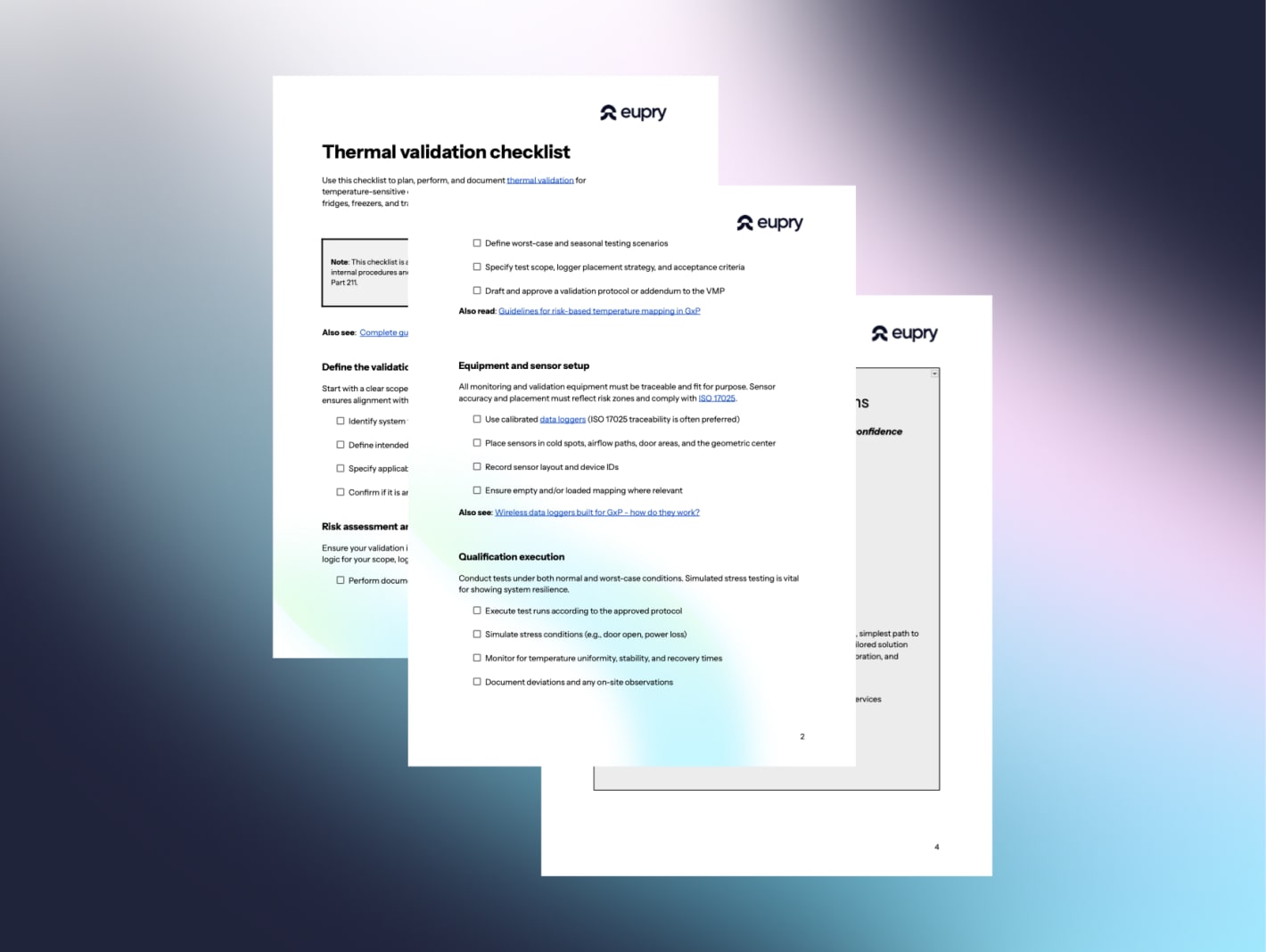Complete guide to thermal validation

Adam Hartmann-Kruckow
Understand the key thermal validation guidelines of GxP to plan, perform, and document your validation activities Step-by-step guidance on how to plan, perform, and document thermal validation activities – fully aligned with GxP requirements.
An step-by-step guideline of the steps you need to perform reliable thermal validations.

Executive summary:
Thermal validation confirms that your temperature-controlled equipment can perform reliably under expected and worst-case conditions. For pharmaceutical and healthcare logistics operations, it is a cornerstone of GxP compliance. This guide outlines when validation is required, how to plan and document it, and what regulators expect. It also highlights common pitfalls, success indicators, and best practices for audit readiness. Whether you manage cold storage, transport, or production, thermal validation is critical for avoiding risk, protecting product quality, and proving control.
Also read: Thermal validation glossary
When to perform thermal validation
Thermal validation is required whenever product quality depends on controlled temperatures. It ensures systems like fridges, freezers, warehouses, and shipping containers operate within defined limits under real-life and worst-case conditions.
You should trigger thermal validation in several key situations. For instance, when commissioning new storage or transport systems, you must demonstrate temperature control before use. Similarly, if you relocate or structurally modify existing units, validation must be repeated. Seasonal testing – such as requalification in summer or winter extremes – ensures consistent performance throughout the year. Validation is also needed after deviations, excursions, or audit findings to demonstrate corrective action.
Finally, when introducing new product types or packaging, a fresh validation may be required to ensure the system’s performance still meets specification. Always document your rationale in the Validation Master Plan (VMP) or protocol.
Also read: What is thermal validation
Audit and regulatory expectations
Thermal validation is a core requirement in GxP frameworks and subject to routine audit scrutiny. Authorities including the EMA, FDA, and WHO expect documented, risk-based validation that shows your equipment operates reliably within specified parameters.
Key guidance includes:
- EU GMP Annex 15: Framework for qualification and validation
- [WHO TRS 1019](](https://www.who.int/publications/m/item/trs1019-annex3): Validation for storage and transport
- FDA Process Validation Guidance: Lifecycle approach to qualification
Auditors will typically ask for:
- Validation protocols and reports
- Sensor placement layouts and justification
- Equipment calibration certificates (ISO 17025 traceability often preferred)
- Records of any deviations and corrective actions
Where thermal validation fits in your compliance strategy
Thermal validation supports both product quality and regulatory compliance. When integrated into your broader quality system, it serves as a foundation for proving that your processes are under control.
It is particularly valuable when paired with temperature mapping and monitoring. Validation results feed into your risk assessments, inform revalidation schedules, and provide evidence for inspections and audits.
Done right, it reduces the risk of product loss, recalls, and regulatory findings – while building confidence in your cold chain compliance.
Also read: What is the difference between mapping and validation

6-step thermal validation checklist
Get a step-by-step PDF for planning and documenting GxP-compliant validation.
Common pitfalls and failure scenarios of thermal validations
Thermal validation can fail or backfire if poorly planned or executed. One common mistake is skipping revalidation after equipment moves or upgrades. Another is relying on uncalibrated or incorrectly placed sensors, which can lead to inaccurate results.
Other frequent issues include outdated or missing VMPs, incomplete stress testing (such as omitting door-open scenarios), and acceptance criteria that are either undefined or overly ambitious. These gaps can all lead to non-conformities, lost product, or audit findings.
Also see: Checklist: 9 temperature mapping mistakes you should avoid
KPIs to track thermal validation success
To evaluate your thermal validation program, track key indicators that highlight effectiveness and compliance. These include:
- Number of validation deviations or CAPAs raised
- Average time to complete a validation or revalidation
- Frequency of audit observations related to temperature control
- Percentage of systems with current, approved validation status
These KPIs help identify weak points, inform improvement plans, and demonstrate control over your validation lifecycle.
Thermal validation process phases
Thermal validation follows the four classic equipment qualification stages used in GxP environments:
- Design qualification (DQ): Confirms that the design meets user and regulatory requirements.
- Installation qualification (IQ): Verifies the equipment is installed as specified and works correctly in its environment.
- Operational qualification (OQ): Demonstrates the system functions within defined parameters under controlled conditions.
- Performance qualification (PQ): Confirms consistent, compliant operation during real-world use.
Each stage should be clearly documented and aligned with your Validation Master Plan (VMP).
Also see: IQ, OQ, and PQ services for GMP and GDP
Thermal validation roles and responsibilities
Effective thermal validation requires cross-functional coordination. Each role contributes to maintaining compliance, avoiding delays, and ensuring the accuracy of your validation efforts.
- Quality Assurance (QA): QA is responsible for oversight of the entire validation process. This includes approving validation protocols, reviewing and signing off final reports, and ensuring that the process aligns with GMP/GDP and internal quality standards. QA also ensures any deviations or non-conformities are properly addressed and documented.
- Engineering and facilities: This team handles the installation, setup, and maintenance of equipment subject to validation. They ensure that the systems are physically ready for qualification activities, implement necessary modifications, and assist with sensor placement and technical troubleshooting during testing.
- Validation team or external vendor: Whether in-house or outsourced, this role owns the planning and execution of the validation itself. Responsibilities include developing protocols, performing temperature mapping, analyzing data, and producing defensible documentation. Vendors also provide calibration certificates, risk assessments, and expert guidance on worst-case scenario design.
- Compliance or regulatory affairs (where relevant): In some organizations, regulatory experts ensure that the thermal validation plan aligns with evolving requirements from authorities like the EMA, FDA, or WHO, and prepare documentation for submission or inspection.
- Operations and logistics: Particularly in distribution settings, operational staff are key to maintaining validated conditions during handling and transport. They are responsible for implementing procedures post-validation and ensuring validated equipment is used as intended.
Clear role definition, documentation of responsibilities in your Validation Master Plan, and open communication across teams are essential. Misalignment or unclear ownership often leads to avoidable delays, audit findings, or validation failures.
Also read: The 4 key teams to involve in your temperature mapping study
Thermal validation tools and equipment
Successful temperature validation depends on using the right tools – and using them correctly. Every component in your setup must be reliable, traceable, and aligned with GxP expectations.
- Data loggers and sensors: Data loggers and relevant temperature and humidity sensors are the backbone of any validation. Choose loggers that are accurate, have a suitable range for your application, and offer sufficient resolution and memory. Placement should reflect a risk-based mapping strategy, including known cold spots, airflow blockages, and access points.
- Calibration: All sensors must be calibrated against a national or international reference standard — ideally ISO 17025 traceable. Certificates must be included in the final validation report, with defined uncertainty ranges and recalibration due dates.
- GxP-compliant software: Data collected must be processed and stored in systems that support audit trails, user control, and secure data integrity. Your software should allow easy reporting and meet ALCOA+ principles.
- Protocol templates and documentation tools: Using standard templates aligned with your Validation Master Plan (VMP) ensures consistency. Include sections for rationale, acceptance criteria, sensor layout diagrams, environmental conditions, and deviations.
- Environmental simulation tools (optional): In advanced setups, thermal loads or environmental chambers are used to simulate worst-case conditions, such as high ambient temperatures or power failure scenarios. Also see: Virtual temperature mapping in GxP – how and why?
All tools must be documented as part of your validation setup. Their traceability, maintenance, and calibration records must be included in your audit-ready documentation — and reviewed before every use. In thermal validation, your tools are only as reliable as their documentation.
Also read: Key guidelines for temperature qualification
Thermal validation in 6 steps
Get a free step-by-step checklist to help you plan, execute, and document thermal validation activities in line with GMP, GDP, and audit expectations.

Perform GxP-compliant thermal validation
- in less time, at a lower cost, with full confidence
For the world’s most regulated industries, Eupry delivers the fastest, simplest path to audit-ready storage validation by combining one digital and GxP-tailored solution covering all you need for temperature compliance (monitoring, calibration, and validation).
- From rentable validation kits to on-site/remote services
- ISO 17025-accredited wireless equipment
- Specialized validation software and digital reporting
Get all the technical information and see how the solutions work
